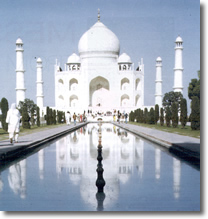Travel Tales
India - Land of Tea
 In my book, MURDER BY ROSES, I talk a little about India and Sri Lanka. During my visit to Agra, India, I posed like every tourist does in front of the fabulous Taj Mahal. (Here I am with my brother below.) This beautiful white marble mausoleum was built by the Mughal emperor Shah Jahan who was heartbroken when his second wife, Mumtaz Mahal, died in childbirth in 1631. After construction was completed by 20,000 men in 1653, as legend goes, the hands of the best workers were cut off so they never could build a more beautiful building. I found this type of cruelty commonplace all around India. Over two million tourists visit this famous monument every year, and I think they were all there that day as we were practically attacked by the residents of Agra pushing and shoving postcards of the Taj in our faces.
In my book, MURDER BY ROSES, I talk a little about India and Sri Lanka. During my visit to Agra, India, I posed like every tourist does in front of the fabulous Taj Mahal. (Here I am with my brother below.) This beautiful white marble mausoleum was built by the Mughal emperor Shah Jahan who was heartbroken when his second wife, Mumtaz Mahal, died in childbirth in 1631. After construction was completed by 20,000 men in 1653, as legend goes, the hands of the best workers were cut off so they never could build a more beautiful building. I found this type of cruelty commonplace all around India. Over two million tourists visit this famous monument every year, and I think they were all there that day as we were practically attacked by the residents of Agra pushing and shoving postcards of the Taj in our faces.
 From there we traveled by car 210 miles to New Delhi. I thought we would never get there that sweltering, fly-infested day, after our taxi driver stopped for thirty minutes not wanting to disturb a white cow blocking the road. No amount of cajoling would get him to proceed, as a Hindu cow worshipper he did not want to offend the animal, honoring its decision to sit in the middle of the road as we melted in the car. Finally, I got out, picked up a stick and prodded the cow to move out of the way, much to the horror of the driver who was yelling at me in Hindustani, something about a woman not interfering with cow dominance! My stepfather told him to move over that he would drive the car right into the cow's rear if it didn't move fast as we were melting without air-conditioning and the flies were driving us crazy. By then about thirty laughing children had circled our car and would not let us continue unless we threw money out the window. We did, and continued to Delhi where we checked into a converted palace hotel. The rooms were enormous, decorated in peacock blues and greens, and had the original "air-conditioning" water ways of white marble in the floors, fanned by huge straw fans to cool the place. I had to look down so as not to trip in them, not expecting to find water in the floor.
From there we traveled by car 210 miles to New Delhi. I thought we would never get there that sweltering, fly-infested day, after our taxi driver stopped for thirty minutes not wanting to disturb a white cow blocking the road. No amount of cajoling would get him to proceed, as a Hindu cow worshipper he did not want to offend the animal, honoring its decision to sit in the middle of the road as we melted in the car. Finally, I got out, picked up a stick and prodded the cow to move out of the way, much to the horror of the driver who was yelling at me in Hindustani, something about a woman not interfering with cow dominance! My stepfather told him to move over that he would drive the car right into the cow's rear if it didn't move fast as we were melting without air-conditioning and the flies were driving us crazy. By then about thirty laughing children had circled our car and would not let us continue unless we threw money out the window. We did, and continued to Delhi where we checked into a converted palace hotel. The rooms were enormous, decorated in peacock blues and greens, and had the original "air-conditioning" water ways of white marble in the floors, fanned by huge straw fans to cool the place. I had to look down so as not to trip in them, not expecting to find water in the floor.
 The next day we walked over to the market place to buy some souvenirs. I bought this red silk sari I am wearing in the photo. My brother bought a musical instrument that resembled a pregnant cello, (I wonder if he ever learned to play that ridiculous instrument since he played trombone in high school.) Dad bought Mom some loose gems of sapphires, rubies, and topaz.
The next day we walked over to the market place to buy some souvenirs. I bought this red silk sari I am wearing in the photo. My brother bought a musical instrument that resembled a pregnant cello, (I wonder if he ever learned to play that ridiculous instrument since he played trombone in high school.) Dad bought Mom some loose gems of sapphires, rubies, and topaz.
As we wandered around the streets we were accosted by crippled children beggars. We were told that some of the mothers purposely break the bones of their babies to convert them into beggars. We had to start throwing coins in the air to get them to leave us alone since they pulled on our clothes. A rather pathetic sight, but when you consider their population explosion of one billion, ninety-five million, three hundred fifty-one thousand and nine hundred ninety-five (1,095,351,995) people, their desperation comes as no surprise.
 In Jaipur, I got motion sick riding the proverbial elephant as the basket oscillated from left to right. I always get motion sick on buses, boats, and elephants, but it has never stopped me from traveling. This trip was very enlightening and educational. It proved to me what happens when birth control is not practiced and then and there I became pro choice.
In Jaipur, I got motion sick riding the proverbial elephant as the basket oscillated from left to right. I always get motion sick on buses, boats, and elephants, but it has never stopped me from traveling. This trip was very enlightening and educational. It proved to me what happens when birth control is not practiced and then and there I became pro choice.
India's diverse economy encompasses traditional village farming, handicrafts, embroidery, and a multitude of services. Government controls on foreign trade and investment have been reduced in some areas, but high tariffs and limits on foreign direct investment are still in place. Despite strong growth, the World Bank worries about the combined state and federal budget deficit. English is the most important commercial communication, but there are 14 other official languages: Bengali, Telugu, Marathi, Tamil, Urdu, Gujarati, Malayalam, Kannada, Oriya, Punjabi, Assamese, Kashmiri, Sindhi, and Sanskrit. Hindustani is a popular variant of Hindi/Urdu, spoken throughout northern India.
In December 2004, a tsunami killed about 60,000 people and severely affected their fishing fleet. India can be hauntingly mysterious and certainly has many wonderful natural resources, like tea, as the Brits found out, but I did not enjoy seeing the cobras dancing out of their baskets to the flute music as I walked in the streets full of crippled children, beggars, flies, and monkeys screeching.
Currently it is a destination and transit area for men, women and children trafficked for forced labor and commercial sexual exploitation. Millions of them are in debt bondage in rice mills, factories, while children endure involuntary servitude as domestic servants, and young girls are forced into sexual exploitation.
It is the world's largest producer of licit opium for pharmaceutical trade, but a certain amount of opium is diverted to illicit international drug markets, with money laundering through the hawala system.
Alinka
Read Travel Tales in the Archives.
